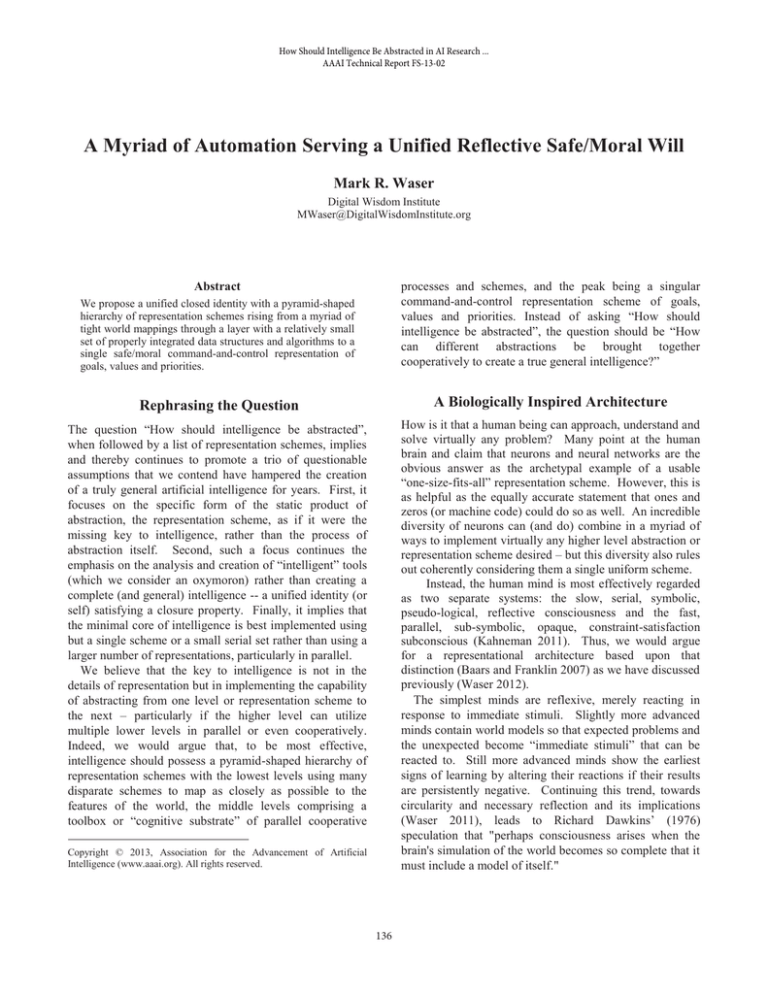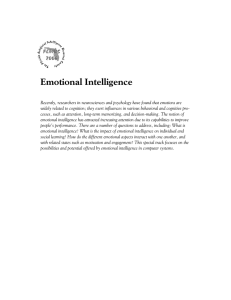
How Should Intelligence Be Abstracted in AI Research ...
AAAI Technical Report FS-13-02
A Myriad of Automation Serving a Unified Reflective Safe/Moral Will
Mark R. Waser
Digital Wisdom Institute
MWaser@DigitalWisdomInstitute.org
Abstract
We propose a unified closed identity with a pyramid-shaped
hierarchy of representation schemes rising from a myriad of
tight world mappings through a layer with a relatively small
set of properly integrated data structures and algorithms to a
single safe/moral command-and-control representation of
goals, values and priorities.
processes and schemes, and the peak being a singular
command-and-control representation scheme of goals,
values and priorities. Instead of asking “How should
intelligence be abstracted”, the question should be “How
can different abstractions be brought together
cooperatively to create a true general intelligence?”
Rephrasing the Question
A Biologically Inspired Architecture
The question “How should intelligence be abstracted”,
when followed by a list of representation schemes, implies
and thereby continues to promote a trio of questionable
assumptions that we contend have hampered the creation
of a truly general artificial intelligence for years. First, it
focuses on the specific form of the static product of
abstraction, the representation scheme, as if it were the
missing key to intelligence, rather than the process of
abstraction itself. Second, such a focus continues the
emphasis on the analysis and creation of “intelligent” tools
(which we consider an oxymoron) rather than creating a
complete (and general) intelligence -- a unified identity (or
self) satisfying a closure property. Finally, it implies that
the minimal core of intelligence is best implemented using
but a single scheme or a small serial set rather than using a
larger number of representations, particularly in parallel.
We believe that the key to intelligence is not in the
details of representation but in implementing the capability
of abstracting from one level or representation scheme to
the next – particularly if the higher level can utilize
multiple lower levels in parallel or even cooperatively.
Indeed, we would argue that, to be most effective,
intelligence should possess a pyramid-shaped hierarchy of
representation schemes with the lowest levels using many
disparate schemes to map as closely as possible to the
features of the world, the middle levels comprising a
toolbox or “cognitive substrate” of parallel cooperative
How is it that a human being can approach, understand and
solve virtually any problem? Many point at the human
brain and claim that neurons and neural networks are the
obvious answer as the archetypal example of a usable
“one-size-fits-all” representation scheme. However, this is
as helpful as the equally accurate statement that ones and
zeros (or machine code) could do so as well. An incredible
diversity of neurons can (and do) combine in a myriad of
ways to implement virtually any higher level abstraction or
representation scheme desired – but this diversity also rules
out coherently considering them a single uniform scheme.
Instead, the human mind is most effectively regarded
as two separate systems: the slow, serial, symbolic,
pseudo-logical, reflective consciousness and the fast,
parallel, sub-symbolic, opaque, constraint-satisfaction
subconscious (Kahneman 2011). Thus, we would argue
for a representational architecture based upon that
distinction (Baars and Franklin 2007) as we have discussed
previously (Waser 2012).
The simplest minds are reflexive, merely reacting in
response to immediate stimuli. Slightly more advanced
minds contain world models so that expected problems and
the unexpected become “immediate stimuli” that can be
reacted to. Still more advanced minds show the earliest
signs of learning by altering their reactions if their results
are persistently negative. Continuing this trend, towards
circularity and necessary reflection and its implications
(Waser 2011), leads to Richard Dawkins’ (1976)
speculation that "perhaps consciousness arises when the
brain's simulation of the world becomes so complete that it
must include a model of itself."
Copyright © 2013, Association for the Advancement of Artificial
Intelligence (www.aaai.org). All rights reserved.
136
The evolution of attention (Ohman, Flykt, and Esteves
2001) demonstrates a solution to AI’s temporal problems.
Also, consciousness’s symbolic nature allows us to create a
grounded world model with fixed pleasure, pain, curiosity
and dissonance points similar to humanity’s evolved innate
traits (Pinker 2003) to ensure that the machine has the
same moral sense and safe motivational system that
humans have (Waser 2010) rather than a dangerous system
of short-sighted, un-evolved drives (Omohundro 2008).
Thus it is not surprising that Hofstadter (2007) argues
that the key to understanding consciousness and (our)
selves is the “strange loop”, the complex feedback network
inhabiting our brains and, arguably, constituting our minds.
Indeed, we would argue that consciousness is intelligence
and that everything else is but reflex and automation
(tools) created either initially by evolution or, in conscious
minds, by automatization (Franklin et al 2007).
The Shortcomings of Symbolic AI
References
The term “Good Old-Fashioned AI (GOFAI)” was coined
to declare that symbol manipulation alone was insufficient
to create intelligence capable of dealing with the real
world. The “frame problem” (McCarthy & Hayes 1969,
Dennett 1984), Searle's (1980) “Chinese Room”, and
Harnad’s (1990) “symbol grounding problem” seemingly
prevent GOFAI from growing beyond closed and
completely specified micro-worlds. While some fully
grounded and bounded systems have had spectacular
successes in endeavors ranging from beating chess grand
masters to autonomous driving (of course, only to
subsequently be declared not to be “true AI” – correctly in
our opinion as they are merely reactive compiled tool),
many others have failed in equally spectacular fashion.
Part of the problem is soluble through embodiment or
the use of linked sub-symbolic systems to sense and map
the world and predict how it will behave (physical
grounding). But this still leaves the larger part of the
problem. Indeed, Perlis (2010) claims that
Baars, B.J. and Franklin, S. 2007. An architectural model of
conscious and unconscious brain functions: Global Workspace
Theory and IDA. Neural Networks 20:955-961.
Cassimatis, N.L. 2006. A Cognitive Substrate for Achieving
Human-Level Intelligence. AI Magazine 27(2): 45-56.
Dawkins, R. 1976. The Selfish Gene. Oxford: Oxford Univ Press.
Dennett, D. 1987. The Intentional Stance. Cambridge, MA: MIT
Press.
Dennett, D. 1984. Cognitive Wheels: The Frame Problem of AI.
In Hookway, C. ed. Minds, Machines & Evolution: Philosophical
Studies, 129-151. New York, NY: Cambridge University Press.
Harnad, S. 1990. The symbol grounding problem. Physica D
42:335-346.
Hofstadter, D. 2007. I Am A Strange Loop. New York, NY:
Basic Books.
Franklin, S.; Ramamurthy, U.; D'Mello, S.; McCauley, L.;
Negatu, A.; Silva R.; and Datla, V. 2007. LIDA: A computational
model of global workspace theory and developmental learning. In
AAAI Tech Rep FS-07-01: 61-66. Menlo Park, CA: AAAI Press.
Kahneman, D. (2011) Thinking, Fast and Slow. New York, NY:
Farrar, Straus and Giroux.
Ohman, A.; Flykt, A.; and Esteves, F. 2001. Emotion Drives
Attention: Detecting the Snake in the Grass. Journal of
Experimental Psychology: General 130:466-478.
Omohundro, S. 2008. The Basic AI Drives. In Wang, P.;
Goertzel, B.; and Franklin, S. eds. Proceedings of the First
Conference on Artificial General Intelligence. Amsterdam: IOS.
Perlis, D. 2010. BICA and Beyond: How Biology and Anomalies
Together Contribute to Flexible Cognition. International Journal
of Machine Consciousness 2(2): 1-11.
Pinker, S. 2003. The Blank Slate: The Modern Denial of Human
Nature. New York, NY: Penguin Books.
Searle, J. 1980. Minds, brains and programs. Behavioral and
Brain Sciences 3(3): 417-457.
Waser, M. R. 2013. Safe/Moral Autopoiesis & Consciousness.
International Journal of Machine Consciousness 5(1):59-74
Waser, M. R. 2012. Safely Crowd-Sourcing Critical Mass for a
Self-Improving Human-Level Learner/"Seed AI". In Biologically
Inspired Cognitive Architectures 2012: 345-350. Berlin: Springer.
Waser, M. R. 2011. Architectural Requirements & Implications
of Consciousness, Self, and "Free Will". In Biologically Inspired
Cognitive Architectures 2011: 438-443. Amsterdam: IOS Press.
Waser, M. R. 2010. Designing a Safe Motivational System for
Intelligent Machines. In Proceedings of the Third Conference on
Artificial General Intelligence: 170-175. Amsterdam: Atlantis.
Rational anomaly-handling (RAH) is then the missing
ingredient, the missing link between all our fancy
idiot-savant software and human-level performance.
Notice the boldness of this claim: not simply do our
systems lack RAH, but this lack is the missing
ingredient.
However, it is our claim that RAH is impossible with the
existential grounding and bounding provided by closure.
As long as intentionality (Dennett 1987) is implicit and
derivative from humans rather than self-contained and
explicit, we will not be able to create flexible, truly general
systems that we can also ensure will be friendly to humans.
The Evolved Solutions of Consciousness
Cassimatis (2006) points to evidence from linguistics,
cognitive psychology, and neuroscience to claim that “a
relatively small set of properly integrated data structures
and algorithms can underlie the whole range of cognition
required for human-level intelligence” and that “once the
problems of artificial intelligence are solved for these" then
"the rest of human-level intelligence can be achieved by
the relatively simpler problem of adapting the cognitive
substrate to solve other problems".
137


